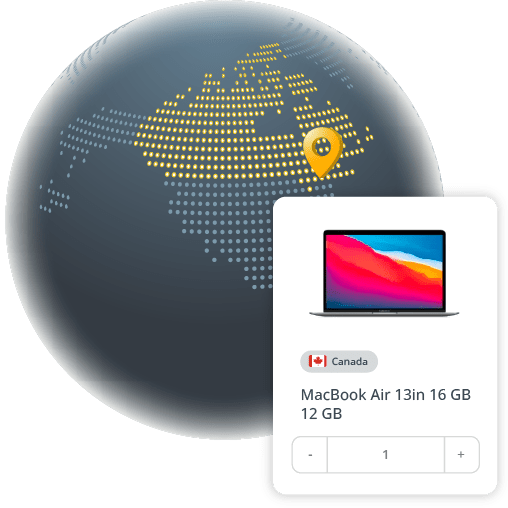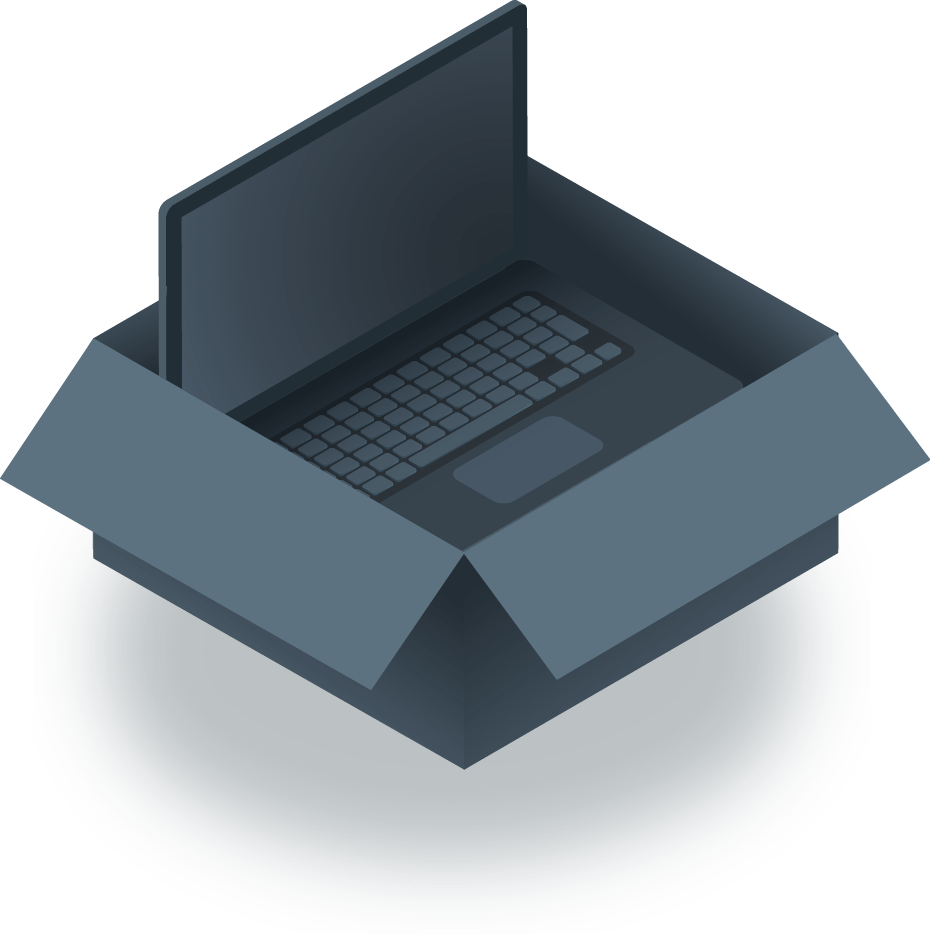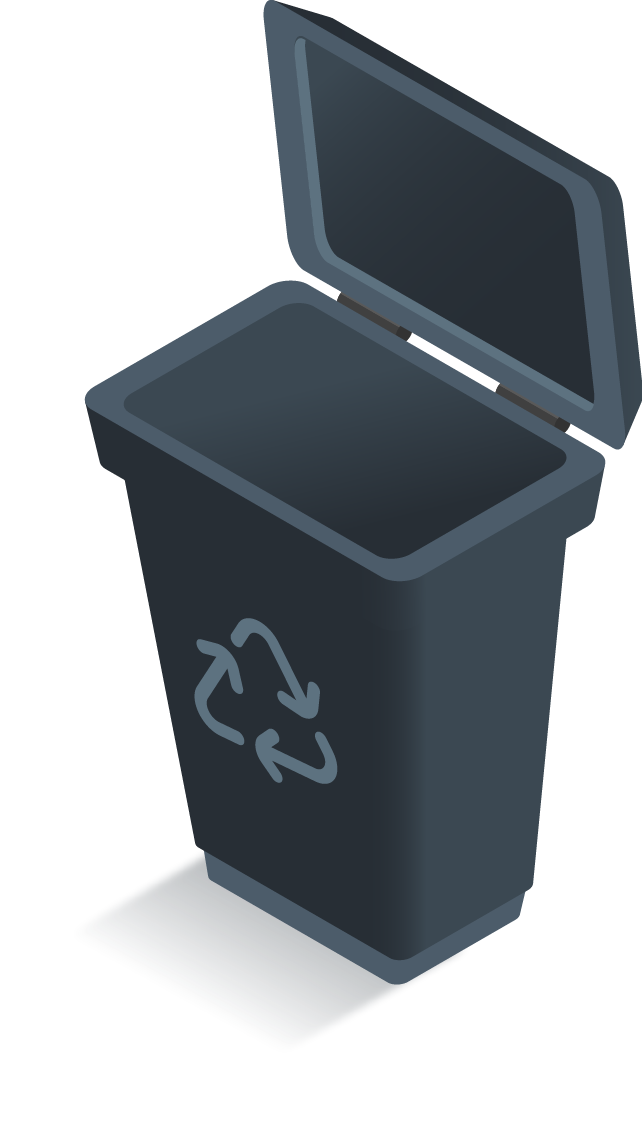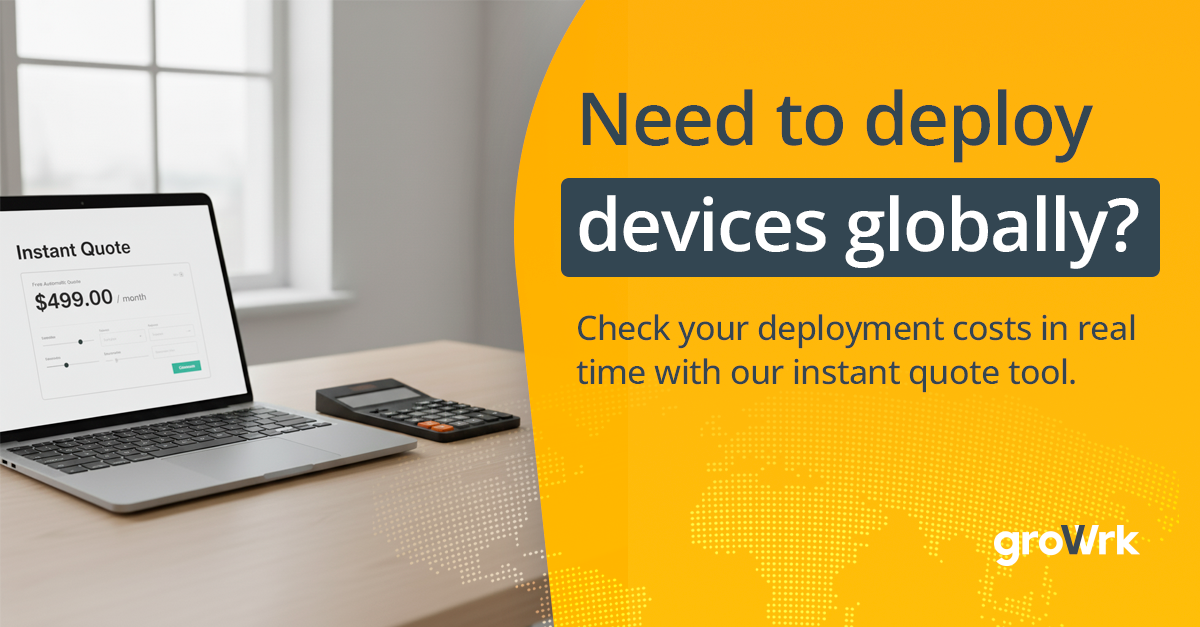How to send IT equipment to Canada
Do you need to send laptops or other IT equipment to your distributed teams in Canada? GroWrk streamlines IT asset management, shipping, and cross-border compliance. Discover how to effortlessly handle logistics, customs, and IT outsourcing for your remote work members in Canada.

At a glance
If you plan to ship IT equipment or outsource IT services to Canada, it's crucial to recognize the country's rising influence in the global IT market. Thanks to its strong infrastructure and thriving tech ecosystem, Canada offers great potential for businesses aiming to grow. Here's what you need to know:
|
CURRENCY Canadian dollar (CAD) |
OFFICIAL LANGUAGE English and French |
TIME ZONE EST / GMT-5 (Ranges nationally from GMT-03:30 to GMT-8) |
|
CUSTOMS DUTY ON ELECTRONICS 5% GST (Goods and Services Tax) of the total value. |
SHIPPING LEAD TIME 2-20 days (may vary with different courier services). |
IT OUTSOURCING MARKET €12.9 billion By 2025, Canada's IT outsourcing market revenue is expected to hit US$12.93bn, showing strong growth. It’s also projected to grow steadily at a rate of 8.18% annually from 2025 to 2029. |
Overview of IT operations in Canada

Digital transformation: Canada is advancing quickly in digital technology, with widespread adoption of cloud computing, AI, and IoT across industries.
Government initiatives: Programs like the "Canada Digital Adoption Program (CDAP)" aim to boost the country's IT infrastructure, attracting innovation and foreign investment.
Skilled workforce: Canada has a strong talent pool of IT professionals, particularly in software development, cybersecurity, and data science.
IT market growth: Canada's IT market is expected to grow steadily, with a projected CAGR of 10.8% from 2024 to 2029. The market is projected to reach $183,796.5 million by 2030.
Geographical advantage: Canada's strategic location in North America offers easy access to key markets, making it an ideal hub for IT services and logistics.
Shipping IT equipment to Canada: What you need to know
| Customs regulations |
| Canada has specific customs regulations for importing IT equipment like laptops, monitors, and other electronics. All goods entering the country are subject to inspection to verify their compliance with Canadian laws. Ensure that all items meet Canada’s safety and environmental standards to avoid any issues at the border. |
| Duties and taxes |
Customs duties and taxes are typically applied when importing IT equipment. The rate varies depending on the type of equipment and its classification under the Canadian Customs Tariff. Be prepared to pay Goods and Services Tax (usually 5%) and possibly additional provincial sales taxes (PST or HST). Customs duties are usually calculated based on the value of the goods, shipping costs, and any applicable tariffs. However, you don’t have to pay any GST on items sent to Canada via mail valued under $20 or gifts by someone under $60. |
| Required documentation |
|
| Import restrictions |
Some IT equipment may be subject to import restrictions, particularly items containing sensitive technologies or proprietary software. Verifying whether any of your shipments fall under these restrictions is crucial.
|
| New vs. Used equipment |
Different rules may apply depending on whether the equipment is new or used. For instance, used electronics may be subject to stricter scrutiny due to environmental concerns, and additional documentation like certificates of origin may be required for used goods. New IT equipment are often processed more easily, though it still must meet all import standards. |
| Data privacy laws |
When outsourcing IT services or sending IT equipment that stores or processes personal data, it's important to consider data privacy regulations. Canada has robust privacy laws, such as the Personal Information Protection and Electronic Documents Act (PIPEDA), which governs how businesses must handle personal data. Businesses involved in IT outsourcing must comply with local privacy laws and international regulations like the General Data Protection Regulation (GDPR) in Europe, if applicable. |
| Penalties or fines for non-compliance |
|
Checklist for sending laptops to Canada
When shipping laptops to Canada, it’s important to follow a few best practices to ensure the process goes smoothly, and your equipment arrives safely and on time. Here are some helpful shipping tips:

Select trusted couriers: Choose reputable couriers such as GroWrk, DHL, UPS, FedEx, or Canada Post for reliable international shipping. These carriers offer tracking services and have experience with Canadian customs regulations.
Check service levels: Depending on urgency, choose express (2-5 days) or standard (5-10 days) shipping. Express services are recommended for high-priority shipments to minimize delays.
Use high-quality packaging: IT equipment is fragile—pack laptops securely in sturdy, padded boxes with protective materials like bubble wrap, foam inserts, or air cushions to prevent damage during transit.
Disassemble where possible: If shipping accessories like docking stations, monitors, or chargers, package them separately to avoid damage. Remove any detachable laptop components if applicable.
Label clearly: Ensure the recipient's name, address, and contact information are clearly labeled—Mark packages as "fragile" to encourage careful handling.
Accurate product descriptions: On the commercial invoice, provide a clear and precise description of the laptop, including brand, model, and serial number. Inaccurate descriptions can lead to customs delays.
Value declaration: Declare the correct value of the laptop to avoid penalties or shipping delays. The declared value affects customs duties and GST/HST charges.
Customs declarations: Complete and include necessary customs paperwork, such as the Canada Customs Invoice (CCI), commercial invoice, and packing list to ensure smooth clearance.
Proof of Origin: If applicable, provide a certificate of origin to determine eligibility for trade agreements like USMCA (if shipping from the U.S. or Mexico), which may reduce customs duties.
GST/HST considerations: Businesses shipping to Canada may need to provide a GST/HST registration number to avoid additional tax liabilities or facilitate tax refunds.
Understand customs fees: Laptops are generally duty-free under Canada’s tariff rules but are subject to GST/HST (5-15%), depending on the province of delivery.
Pre-pay duties and taxes: Some couriers allow for pre-paid duties and taxes to simplify delivery and prevent the recipient from facing unexpected charges upon arrival.
Protect against loss or damage: Consider shipping insurance for high-value laptops to safeguard against loss, theft, or damage during transit.
Compliance with Canadian regulations: Ensure compliance with Canada’s electrical safety and environmental standards, such as RoHS (Restriction of Hazardous Substances) and EPR (Extended Producer Responsibility) for electronics.
Use tracking tools: Major couriers provide real-time tracking—monitor the shipment’s progress to anticipate any customs or transit delays.
Stay in touch with the recipient: Inform the recipient about expected delivery times, potential customs processes, and any tracking updates to ensure a smooth handoff.
Expect Weather and Seasonal Delays: Winter storms and holiday shipping congestion can slow deliveries—factor in potential delays when scheduling shipments.
Canadian delivery options: For final delivery, consider working with Canada Post, Purolator, or regional courier services for efficient last-mile delivery within Canada.

Average cost of IT Equipment in Canada
Laptops (Business Grade):
- Mid-range: $670 - $1,330 USD
- High-end: $1,330 - $2,800+ USD
High-end models such as Apple MacBook Pro, Dell XPS, and Lenovo ThinkPad are priced on the higher end.
Monitors (Business Grade):
- Standard: $150 - $330 USD
- Ultrawide/4K: $370 - $890 USD
Monitors from trusted brands like Dell, Samsung, and LG typically range within these prices, with 4K or ultrawide models costing more.
Desktops (Business Grade):
- Standard Desktop PC: $520 - $1,480 USD
- Workstation Desktop (for high-performance tasks): $1,480 - $3,330+ USD
Prices depend on the brand and specifications, with options from HP, Lenovo, and Apple among the most common.
Printers (Laser):
- Standard Office Printers: $150 - $370 USD
- High-Volume Printers: $520 - $1,850+ USD
Leading brands such as HP, Canon, and Brother offer a wide range of models for office environments.
Public holidays & IT work hours to plan your shipment
Key public holidays in Spain:
- New Year's Day – January 1
- Good Friday – Friday before Easter Sunday
- Easter Monday – Monday after Easter
- Victoria Day – Last Monday before May 25
- Canada Day – July 1
- Labor Day – First Monday in September
- Thanksgiving Day – Second Monday in October
- Remembrance Day – November 11 (observed in most provinces)
- Christmas Day – December 25
- Boxing Day – December 26
Typical work hours for IT professionals
-
Work week: The standard work week for IT professionals in Canada is generally from 9 AM to 5 PM, Monday through Friday. However, flexible hours are becoming more common, especially in the tech sector.
-
Overtime and flexibility: IT professionals may also work flexible hours or on-call shifts depending on the nature of the work, particularly in critical areas like network security or system maintenance.
- Remote work: Given the rise of remote work, many IT professionals in Canada enjoy the flexibility to work from home or on hybrid schedules.
What to consider when retrieving IT equipment from employees in Canada?
| Local delivery and logistics services |
|
| IT Inventory Management |
|
| Logistics challenges for remote locations |
|
| Equipment agreement with employees |
|
How to dispose of IT equipment in Canada
Data wiping
Before disposal, ensure all data is securely erased to prevent unauthorized access. The Canadian Centre for Cyber Security recommends using certified data sanitization methods.
Utilize certified E-Waste recyclers
Partner with certified e-waste recycling companies and ITAD service providers that adhere to environmental standards and provide certificates of destruction. This ensures compliance and protects your organization from potential data breaches.
Environmental compliance
Canadian authorities require companies to responsibly dispose of electronic waste (e-waste) to prevent environmental harm. E-waste includes unwanted electronic equipment, such as smart devices, used cables, batteries, and fluorescent lights. Improper disposal can lead to the release of hazardous substances like mercury and lead.

Local IT Outsourcing Solutions in Canada
You can streamline your IT logistics and asset management with GroWrk’s comprehensive global solution. Whether it’s shipping equipment or managing IT assets across multiple regions, GroWrk helps you stay compliant and efficient, every step of the way. Here’s why GroWrk is the ideal partner for managing your IT assets in Canada:

| 1. Wide global coverage |
| With operations in over 150 countries, including Canada, GroWrk guarantees smooth deployment and management of your IT equipment for remote teams. Whether your employees are in Toronto, Vancouver, Montreal, or remote locations, we ensure timely and hassle-free service to keep your business running efficiently. |
| 2. End-to-end asset management |
GroWrk simplifies the entire IT asset lifecycle, covering procurement, deployment, management, and retirement. By handling logistics, compliance, and security, we allow your team to focus on business growth, while we take care of IT operations. |
| 3. Intuitive platform for easy deployment |
GroWrk’s user-friendly platform makes it effortless to deploy and manage IT devices in Canada. With just a few clicks, you can order, ship, and track equipment, reducing administrative overhead and minimizing costly errors. Our platform streamlines IT operations, cutting down on time and costs. |
| 4. Smooth delivery and equipment retrieval |
From delivering laptops, monitors, and IT accessories to remote employees across Canada to retrieving assets from outgoing team members, GroWrk handles it all. We simplify the process so your team can focus on what matters most—delivering results. |
| 5. Compliance with Canadian import regulations |
GroWrk ensures that all shipments adhere to Canadian import requirements, including customs duties, tax compliance, and environmental regulations. By managing these details, we eliminate the risk of delays or fines, ensuring your IT equipment arrives on time and fully compliant. |
| 6. Efficient repairs and maintenance |
GroWrk manages the entire repair and maintenance process, ensuring your devices remain in top working condition. From routine checkups to emergency fixes, we handle everything—allowing your teams to stay productive without worrying about technical disruptions. |
| 7. 24/7 Support for peace of mind |
Whether you need shipping, asset management, or troubleshooting assistance, GroWrk offers round-the-clock customer support. Our team is available anytime to guide you through the complexities of IT asset management and resolve any issues quickly. |
Procure, configure, and deploy your IT devices from one platform


